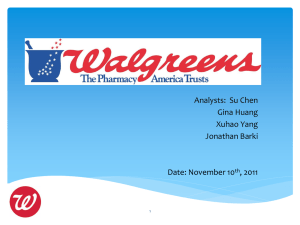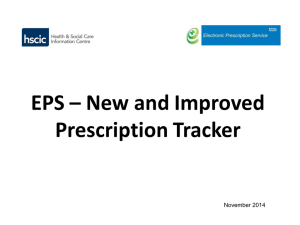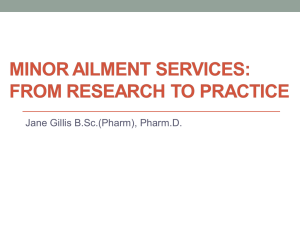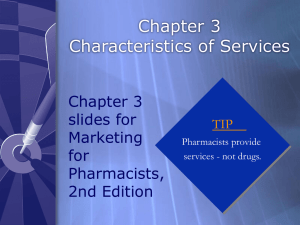Law-Update-LSweeney2012
advertisement
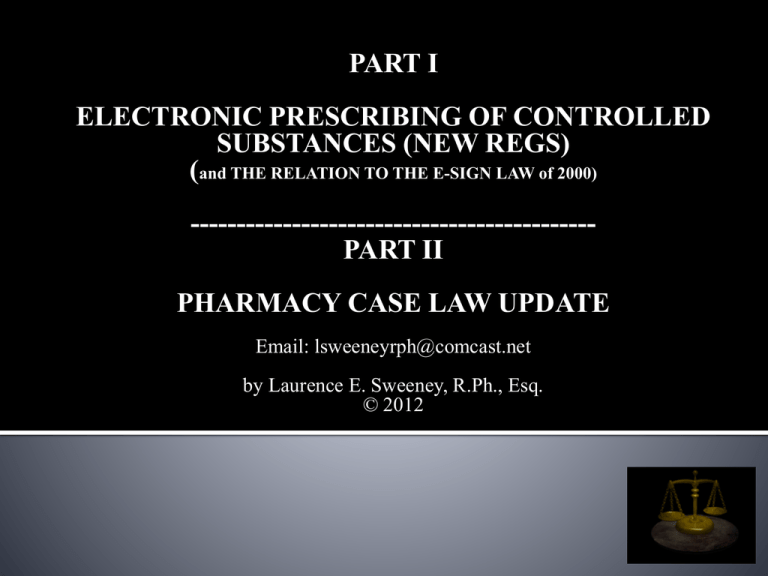
PART I ELECTRONIC PRESCRIBING OF CONTROLLED SUBSTANCES (NEW REGS) (and THE RELATION TO THE E-SIGN LAW of 2000) -------------------------------------------PART II PHARMACY CASE LAW UPDATE Email: lsweeneyrph@comcast.net by Laurence E. Sweeney, R.Ph., Esq. © 2012 2 E-SIGN 3 When was the first court case to determine the validity of an electronic signature………. E-SIGN 4 In Howley v. Whipple, the New Hampshire Supreme Court determined that the traditional method of signing is not the only way to make a document binding in the absence of additional proof This 1869 case dealt with the telegraph as the means for forming a signature in a contract 5 “It makes no difference whether [the telegraph] operator writes the offer or the acceptance in the presence of his principal and by the principal’s express direction, with a steel pen an inch long attached to an ordinary penholder, or whether his pen be a copper wire a thousand miles long. In either case the thought is communicated to the paper by the use of the finger resting upon the pen. Nor does it make any difference that in one case common record ink is used, while in the other case a more subtle fluid, known as electricity, performs the same office.” 6 ELECTRONIC PRESCRIBING OF CONTROLLED SUBSTANCES (NEW REGS) (as of 2010) 7 3 Federal Laws affect the practice of pharmacy with respect to controlled substances signatures (NOTE: State Law Must Also Allow) : 1. New federal regulations regarding electronically prescribing CII-CV Rxs (21 CFR 1311) 2. Current federal regulations regarding prescriptions (21 CFR 1300 et seq.) 3. The E-Sign law of 2000 (and State UETA laws) 4. State Laws also apply. 8 Title 21 CFR, Part 1300-1399 As of April 1, 2011 PART 1300 - DEFINITIONS PART 1301- REGISTRATION OF MANUFACTURERS, DISTRIBUTORS, AND DISPENSERS OF CONTROLLED SUBSTANCES PART 1302- LABELING AND PACKAGING REQUIREMENTS FOR CONTROLLED SUBSTANCES PART 1303 - QUOTAS PART 1304- RECORDS AND REPORTS OF REGISTRANTS PART 1305- ORDER FORMS PART 1306- PRESCRIPTIONS PART 1307- MISCELLANEOUS PART 1308- SCHEDULES OF CONTROLLED SUBSTANCES PART 1309- REGISTRATION OF MANUFACTURERS, DISTRIBUTORS, IMPORTERS AND EXPORTERS OF LIST I CHEMICALS PART 1310- RECORDS AND REPORTS OF LISTED CHEMICALS AND CERTAIN MACHINES PART 1311- DIGITAL CERTIFICATES PART 1312- IMPORTATION AND EXPORTATION OF CONTROLLED SUBSTANCES PART 1313- IMPORTATION AND EXPORTATION OF PRECURSORS AND ESSENTIAL CHEMICALS PART 1314- RETAIL SALE OF SCHEDULED LISTED CHEMICAL PRODUCTS PART 1315- IMPORTATION AND PRODUCTION QUOTAS FOR EPHEDRINE, PSEUDOEPHEDRINE, AND PHENYLPROPANOLAMINE PART 1316- ADMINISTRATIVE FUNCTIONS, PRACTICES, AND PROCEDURES PART 1321-DEA MAILING ADDRESSES 9 21 CFR 1311 et seq. Requirements for Electronic Orders and Prescriptions ∞ Published in Federal Register 05-31-2010 ∞ Effective 06-01-2010 10 PART 1311 DIGITAL CERTIFICATES Subpart A General Section 1311.01 Scope Section 1311.02 Definitions Section 1311.05 Standards for technologies for electronic transmission of orders Section 1311.08 Incorporation by reference Subpart B Obtaining and Using Digital Certificates for Electronic Orders Section 1311.10 Eligibility to obtain a CSOS digital certificate Section 1311.15 Limitations on CSOS digital certificates Section 1311.20 Coordinators for CSOS digital certificate holders Section 1311.25 Requirements for obtaining a CSOS digital certificate Section 1311.30 Requirements for storing and using a private key for digitally signing orders Section 1311.35 Number of CSOS digital certificates needed Section 1311.40 Renewal of CSOS digital certificates Section 1311.45 Requirements for registrants that allow powers of attorney to obtain CSOS digital certificates under their DEA registration Section 1311.50 Requirements for recipients of digitally signed orders Section 1311.55 Requirements for systems used to process digitally signed orders Section 1311.60 Recordkeeping 11 Subpart C—Electronic Prescriptions §1311.100 General §1311.102 Practitioner responsibilities §1311.105 Requirements for obtaining an authentication credential--Individual practitioners §1311.110 Requirements for obtaining an authentication credential--Individual practitioners eligible to use an electronic prescription application of an institutional practitioner §1311.115 Additional requirements for two-factor authentication §1311.116 Additional requirements for biometrics §1311.120 Electronic prescription application requirements §1311.125 Requirements for establishing logical access control--Individual practitioner §1311.130 Requirements for establishing logical access control--Institutional practitioner §1311.135 Requirements for creating a controlled substance prescription §1311.140 Requirements for signing a controlled substance prescription §1311.145 Digitally signing the prescription with the individual practitioner's private key §1311.150 Additional requirements for internal application audits §1311.170 Transmission requirements §1311.200 Pharmacy responsibilities §1311.205 Pharmacy application requirements §1311.210 Archiving the initial record §1311.215 Internal audit trail §1311.300 Application provider requirements--Third-party audits or certifications §1311.302 Additional application provider requirements §1311.305 Recordkeeping 12 Background: DEA has previously never allowed electronic signatures on prescriptions for controlled substances. Originally 3 Methods: Oral, written, faxed. Faxed prescriptions: Have been are still are allowed, but it must be “a facsimile of a signed paper prescription transmitted by the practitioner or the practitioner's agent to the pharmacy.” 21 CFR 1306.21 13 The DEA considers faxed prescriptions PAPER prescriptions and, therefore, they MUST be MANUALLY signed. “A faxed prescription is a paper prescription and, therefore, must be manually signed by the prescribing practitioner registered with DEA to prescribe controlled substances.” 75 FR 16264 March 31, 2010 (interim final rule on elec. Rxs) A signature created by a stylus on an electronic device is digital and is NOT a manual signature!!! Manual Signature = PEN TO THE PAPER! 14 21 CFR 1311 (The New Regs) NOW Electronic OK – BUT must be in compliance with new regs. WRITE --- RECEIVE --- ARCHIVE Providers can write for controlled substances electronically, including schedule II substances. Pharmacies can receive electronic prescriptions for controlled substances in schedule II-V. Pharmacies must archive the records electronically (if electronic rx it must be maintained electronically) (nothing prevents paper record but it MUST be maintained electronically) 15 Specific software and other requirements and procedures must be met for valid transmittal of electronic controlled substance prescriptions . The new electronic prescribing regs do NOT mean electronic signatures FAXED to a pharmacy are valid. 16 NO Physicians have the option of writing electronically for controls. Pharmacies have the option of accepting electronically prescribed controls. The DEA considers the use of electronically prescribed controls as strictly voluntary Prescribers may still write for controls as before, or fax or call in C III, IV and V Rxs. 17 YES. “Nothing in this chapter shall be construed as authorizing or permitting any person to do any act which such person is not authorized or permitted to do under other Federal laws or obligations under international treaties, conventions or protocols, or under the law of the State in which he/she desires to do such act nor shall compliance with such parts be construed as compliance with other Federal or State laws unless expressly provided in such other laws.” 21 CFR 1307.02 [i.e., no preemption] This is why some states do not allow oral CIII,IV and V Rxs even though the DEA does. Generally, the more restrictive law applies. If state law is more restrictive, must follow state law (unless preempted – e.g., See E-Sign Law below which has preemption) 18 NOW. However, both the prescriber’s computer system AND the pharmacy’s computer system must be compliant with the stringent requirements in the interim final rule. 19 The application provider must either hire a qualified third party to audit the application or have the application reviewed and certified by an approved certification body. The auditor or certification body will issue a report that states whether the application complies with the DEA’s requirements and whether there are any limitations on its use for controlled substance prescriptions. The application provider must provide a copy of the report to the practitioners or pharmacies to allow them to determine whether the application is compliant. 20 YES, BUT A practitioner may use an existing electronic prescription or Electronic Health Record (EHR) application that doesn’t yet comply with the interim final rule to prepare and print a controlled substance prescription so that the other electronic prescribing functionality may be used, but until the application is compliant, the practitioner will have to print the prescription for manual signature. Such a prescription is a paper prescription and subject to existing rules. It may then be handed to the patient or faxed to the pharmacy. A pharmacy cannot process electronic prescriptions until the application is compliant, but it may use the application to store data from printed, manually signed prescriptions or oral prescriptions entered or scanned into the computer as they currently do, and the paper records from controlled substances must be retained 21 BEFORE the application is used to sign or transmit electronic prescriptions (practitioners) BEFORE the application is used to process controlled substance prescriptions (pharmacies) AFTER the applications are being use by practitioners or pharmacies WHENEVER a FUNCTIONALITY as it relates to controlled substances is ALTERED, or EVERY TWO(2) YEARS, whichever occurs first 22 Third-Party Audits and Certifications apply to the application provider, NOT to the individual practitioner, institutional practitioner or the pharmacy UNLESS, the application is proprietary (i.e., developed by the individual practitioner, institutional practitioner or pharmacy) 23 NEED 2 OUT OF THE 3: 1. Something you know (e.g., a password) 2. Something you have (a hard token – e.g., a smart card or USB device) – must be stored or kept separate from the computer being accessed with only prescriber control 3. Something you are (a biometric – e.g., a fingerprint, iris scan) 24 PRACTITIONER: sole possession of hard token or password! Notification in 1 business day if lost or stolen! If not compliant, can lose DEA registration 2 PEOPLE assigned to issuance and control of application and one must be a DEA registrant Requirements for obtaining an authentication credentials complex - Section 1311.105. The credential service provider or certification authority must issue the authentication credential using two channels ( e.g., e-mail, mail, or telephone call). 25 The practitioner will use the two-factor credential to sign the prescription; that is, using the two-factor credential will constitute the legal signature of the DEA-registered prescribing practitioner. 26 NO A practitioner is not permitted to issue prescriptions for multiple patients with a single signature. May sign multiple prescriptions for a single patient at one time as long as he/she indicates each rx is ready to be signed Each controlled substance prescription will have to be indicated as ready for signing, but a single execution of the two-factor authentication protocol can then sign all prescriptions for a given patient that the practitioner has indicated as being ready to be signed. 27 NO. Signing and transmitting an electronic controlled substance prescription are two distinct actions. Electronic prescriptions for controlled substances should be transmitted as soon as possible after signing, however, it is understood that practitioners may prefer to sign prescriptions before office staff add pharmacy or insurance information, therefore, DEA is not requiring that transmission of the prescription occur simultaneously with signing the prescription. 28 YES. Electronic prescription application may print copies of the transmitted prescription(s) if they are clearly labeled: “Copy only – not valid for dispensing.” List of prescriptions transmitted may be printed for patients if the list indicates that it is for informational purposes only and not for dispensing. **The copies must be printed after transmission. If an electronic prescription is printed prior to attempted transmission, the electronic prescription application must not allow it to be transmitted. ** 29 IF TRANSMISSION FAILS, MAY INTERMEDIARY CONVERT TO A DIFFERENT FORMAT (I.E., CHANGE IT TO A FAXED PRESCRIPTION)? NO. Electronic prescription must be transmitted from the practitioner to the pharmacy in its electronic form. If an intermediary cannot complete a transmission of a controlled substance prescription, the intermediary must notify the practitioner. 30 Under such circumstances, if the prescription is for a schedule III, IV, or V controlled substance, the practitioner can print the prescription, manually sign it, and fax the prescription directly to the pharmacy. **This prescription must indicate that it was originally transmitted to a specific pharmacy (and name the pharmacy), the date and time of transmission, and the fact that the electronic transmission failed.** [see pharmacy responsibility below if they receive such a faxed prescription] 31 The DEA-required contents of a prescription shall not be altered during transmission between the practitioner and pharmacy. However, this requirement only applies to the content (not the electronic format used to transmit the prescription). This requirement applies to actions by intermediaries. It does not apply to changes that occur after receipt at the pharmacy. Changes made by the pharmacy are governed by the same laws and regulations that apply to paper prescriptions. [see below, pharmacy annotations and alterations] 32 • • What must a pharmacy application do? (21 CFR 1311.205) Accurately and consistently: • Import • Display • Store all the required contents of a controlled substance prescription, indication of signing, digital signature, and number of refills 33 The pharmacy must determine which employees are authorized to enter information regarding the dispensing of controlled substance prescriptions and annotate or alter records of these prescriptions (to the extent such alterations are permitted under this chapter). The pharmacy must ensure that logical access controls in the pharmacy application are set so that only such employees are granted access to perform these functions 34 When a pharmacist receives a paper or oral prescription that indicates that it was originally transmitted electronically to the same pharmacy, the pharmacist must check its records to ensure that the electronic version was not received and the prescription dispensed. If both prescriptions were received, the pharmacist must mark one as void. 35 When a pharmacist receives a paper or oral prescription that indicates that it was originally transmitted electronically to another pharmacy, the pharmacist must check with that pharmacy to determine whether the prescription was received and dispensed. If the pharmacy that received the original electronic prescription had not dispensed the prescription, that pharmacy must mark the electronic version as void or canceled. If the pharmacy that received the original electronic prescription dispensed the prescription, the pharmacy with the paper version must not dispense the paper prescription and must mark the prescription as void. 36 What changes can be made by the pharmacy AFTER receipt of an electronic prescription? Changes made by pharmacies are subject to the same rules that apply to all prescriptions for controlled substances. 75 FR 16281, No. 61 37 CHANGES TO CII vs. CHANGES to CIII,IV, & V Same rule applies to electronic rxs and paper rxs for changes to the prescription. Prohibition to changes of content of electronic rx applies only to intermediaries. But what changes can be made? 38 CII Changes: Previous DEA policy allowed changes to CII prescriptions the same as a CIII-V (see below for such changes that may be made) On November 19, 2007, DEA issue rule on Issuance of Multiple Prescriptions for Schedule II Controlled Substances. PRAMBLE to that rule created problem….. 39 …Preamble to Multiple CII Rxs regulation stated that: "the essential elements of the [schedule II] prescription written by the practitioner (such as the name of the controlled substance, strength, dosage form, and quantity prescribed)…may not be modified orally.“ This contradicted previous policy of allowing changes to a CII prescription. 40 DEA recognized resulting confusion and plans on resolving in future with additional rule….. Until then… DEA states: Until that time, pharmacists are instructed to adhere to state regulations or policy regarding those changes that a pharmacist may make to a schedule II prescription after oral consultation with the prescriber. What if state law is silent?????? 41 The pharmacist may add or change the patient’s address upon verification. The pharmacist may add or change the dosage form, drug strength, drug quantity, directions for use, or issue date only after consultation with and agreement of the prescribing practitioner. Such consultations and corresponding changes should be noted by the pharmacist on the prescription. Pharmacists and practitioners must comply with any state/local laws, regulations, or policies prohibiting any of these changes to controlled substance prescriptions. The pharmacist is never permitted to make changes to the patient’s name, controlled substance prescribed (except for generic substitution permitted by state law) or the prescriber’s signature. 42 CASE LAW UPDATES 43 THE “LEARNED INTERMEDIARY DOCTRINE” Traditionally, the learned-intermediary doctrine has been used to insulate drug manufacturers from liability in productsliability lawsuits. The physician becomes the intermediary between the drug manufacturer and the patient. 44 Under the learned-intermediary doctrine, a drug manufacturer is immune from liability to a patient for “failure to warn” so long as the manufacturer has provided the patient's doctor with all relevant safety information for that drug. It is then up to the patient's doctor—who has the benefit of knowing the patient's specific situation—to convey to the patient any information that the doctor deems relevant. That is, the doctor is in the “best position” to warn the patient. Thus, he is the “learned intermediary” best suited to provide a warning. 45 EXCEPTIONS: Exemptions began to emerge beginning with birth control pills where the doctor takes almost a passive role, prescribing the BC to patients at their request. Drug manufacturers thus were required to provide additional warnings to the patient by patient package inserts Also, with newer “direct-to-consumer” advertising in TV, magazines, radio, greater warnings DIRECT to consumers is required But the general rule still applies. 46 Jurisdictions adopting the learned-intermediary doctrine in the context of pharmacist/customer tort litigation have put forth a similar rationale: that between the doctor and the pharmacist, the doctor is in the best position to warn the customer of a given medication's generalized risks Or, viewed more pragmatically, the doctrine prevents pharmacists from constantly secondguessing a prescribing doctor's judgment simply in order to avoid his or her own liability to the customer. 47 CASES THAT CHIP AWAY AT THE DEFENSE Nail v. Publix Super Markets, Inc., No. 1091740, S. Ct. Ala., 2011 Ala. LEXIS 69, May 13, 2011 ▪ rejecting a defense motion for summary judgment, a duty to warn case against a pharmacy based on the learned intermediary doctrine where plaintiff claimed that the pharmacist had a duty to warn her of the increased drug dosage (which she alleged caused her injury) versus a duty to warn of drug side effects, which may impact the doctor/patient relationship. 48 Nail v. Publix Super Markets, Inc., (Cont’d) ▪ BACKGROUND: Patient had refilled a 1mg Coumadin prescription for past 3 years. Prescriber subsequently called in a prescription for 5mg Coumadin instead of 1mg. She had been taking 5mg by using 5 of the 1mg tablets. The 1mg Rx did not have specific directions but said “use as directed,” and had been filled 15 times. ▪ New Rx as continuation was called in but as 5mg tablets with same “use as directed” directions. ▪ Patient picked up 5mg Rx and signed form DECLINING COUNSELING, but said was just asked to sign form. 49 Nail v. Publix Super Markets, Inc., (Cont’d) ▪ Plaintiff, Nail, provided expert (pharmacist) testimony as to standard of care being to counsel on change of dose of dangerous medications. ▪ Plaintiff’s argument was not that the pharmacist should have warned of the dangerous propensity or side effects of the Coumadin but, rather, that they had a duty to inform them of the change in dose. 50 Nail v. Publix Super Markets, Inc., (Cont’d) The court in Nail upheld the learned intermediary doctrine, but still allowed the case to go forward, finding the doctrine inapplicable in this case. ▪ HELD: Under the learned-intermediary doctrine, the pharmacist does not have a duty to warn customers of the hazardous side effects either orally or by way of the manufacturer's package insert. However, Nail is arguing that the pharmacist should have told her that there was a significant change in her dosage of a very dangerous drug, not that Publix should have warned her against any possible harm in taking that dosage amount. Notifying a customer that there has been a change in prescription strength does not infringe upon the physician-patient relationship. 51 CASES THAT CHIP AWAY AT THE DEFENSE A TROUBLESOME CASE! (bad law or bad lawyering?) Klasch v. Walgreen Co., Supreme court of the State of Nevada, 54805, Nov. 23, 2011. This case raises concern for the continued viability of the learned intermediary defense and, indeed, for the extent of liability imposed even when a pharmacist takes reasonable steps to avoid injury. 52 Klasch v. Walgreen, Co. (cont’d) Background: Helen Klasch visited Fredrick Tanenggee, M.D., for the first time in December, 2005. On her paperwork she indicated that she might have a sulfa allergy. After discussion, it was recorded in her medical file under allergies as “Sulfa?” In July, 2006, Klasch returned to Dr. Tanenggee complaining of “abdominal fullness.” 53 Klasch v. Walgreen, Co. (cont’d) Klasch was diagnosed with a urinary tract infection. Dr. Tanenggee told Klasch that under normal circumstances, her infection could be treated most effectively with Bactrim. Given the notation in her chart, however, Dr. Tanenggee asked Klasch to clarify how certain she was of her sulfa allergy. After some further discussion, Klasch downplayed the previous notation and asked Dr. Tanenggee to write her a prescription for Bactrim. Dr. Tanenggee complied, and Klasch dropped off the prescription at Walgreens Pharmacy on her way home from Dr. Tanenggee's office. 54 Klasch v. Walgreen, Co. (cont’d) Later that day, Klasch’s caretaker returned to the pharmacy to pick up the prescription, and a pharmacy employee told the caretaker the prescription was not ready because it had been “flagged” because of the possible sulfa allergy. The caretaker asked the pharmacy to call Klasch directly to discuss the issue. The employee called Klasch. 55 Klasch v. Walgreen, Co. (cont’d) Klasch reportedly indicated that she had taken Bactrim in the past and that she had not experienced any adverse reaction to it. Based on this information and clarification provided by the patient, the pharmacist overrode the “flag” and filled the prescription and released it to the caretaker. 56 Klasch v. Walgreen, Co. (cont’d) Later that day, after taking the medication, Klasch complained that she felt "itchy." The following day, Klasch called Dr. Tanenggee's office and left a voice mail in which she stated that she was wrong about not having a sulfa allergy. Klasch's condition continued to worsen, and she was taken to the emergency room. After being diagnosed with SJS/TEN, Klasch was transferred to a burn center, where she eventually lapsed into a coma and passed away. At the time Klasch was removed from life support, she had burns covering 40 to 50 percent of her body. 57 Klasch v. Walgreen, Co. (cont’d) Klasch's two children brought a wrongful-death action against Walgreens, alleging that its pharmacist breached the duty of care owed to their mother. Specifically, the Klasches contended that Walgreens' pharmacist breached her duty of care by failing to adequately warn Klasch of the prescribed medication's risks in light of her allergy to it or, alternatively, by failing to call Dr. Tanenggee to clarify whether he really meant to prescribe a medication to which she was allergic. 58 Klasch v. Walgreen, Co. (cont’d) At the trial level, Walgreen’s filed a motion for summary judgment, using the “learned intermediary” defense, claiming that it had no duty to warn. The trial court, following what it perceived to be the “majority rule” allowed Walgreen’s motion and dismissed the case. Klasch’s estate appealed. 59 Klasch v. Walgreen, Co. (cont’d) On appeal, the appellate court for the first time in that state “adopt[ed] the learned-intermediary doctrine in the context of pharmacist/customer tort litigation and [held] that pharmacists have no duty to warn of a prescribed medication's generalized risks.” BUT, the court went on to address whether the doctrine applies when there is a “known customer-specific risk.” 60 Klasch v. Walgreen, Co. (cont’d) Despite the fact that there was a discussion between the pharmacy and the patient about the possible allergy, and despite the fact that the patient said she had taken the drug with no problems before, and despite the fact that the doctor had the same information as the pharmacy and prescribed the drug, the court still denied the learned intermediary doctrine defense in this case! 61 Klasch v. Walgreen, Co. (cont’d) In denying the learned-intermediary defense to Walgreens, the court stated it rational. The Klasch court adopted the reasoning of Happel v. Wal-Mart Stores, Inc., 199 Ill.2d 179, 262 Ill.Dec. 815, 766 N.E.2d 1118 (2002) (an Illinois case). Happel involved a specific known risk to a patient – an allergy to aspirin and prescribed toradol. 62 Klasch v. Walgreen, Co. (cont’d) The Klasch court reasoned: ▪ “We find the analysis of the Happel court persuasive. Consistent with the Supreme Court of Illinois and what we perceive to be the modern trend of case law, we hold that the learned-intermediary doctrine does not insulate a pharmacist from liability when he or she has knowledge of a customer-specific risk. Instead, when a pharmacist has such knowledge, the pharmacist has a duty to warn the customer or to notify the prescribing doctor of the customer-specific risk.” 63 Klasch v. Walgreen, Co. (cont’d) THE COURT’S HOLDING: “By insulating pharmacists from liability for failing to warn their customers of a medication's generalized risks, the learnedintermediary doctrine prevents pharmacists from interfering with the doctor-patient relationship. Because the public-policy considerations behind this doctrine are sound, we adopt it in the context of pharmacist/customer tort litigation. These public-policy considerations are less persuasive, however, when a pharmacist has knowledge of a customer-specific risk with respect to a prescribed medication. Accordingly, in such circumstances, the learned-intermediary doctrine does not insulate a pharmacist from liability, and the pharmacist instead has a duty to exercise reasonable care in warning the customer or notifying the prescribing doctor of this risk.” (Emphasis added). 64 Klasch v. Walgreen, Co. (cont’d) The Klasch court holding itself makes sense, that if a pharmacist knows of a specific risk to a specific patient (such as a drug interaction or drug allergy) he should warn the patient or doctor, BUT, in the Klasch case the pharmacist took reasonable steps to ascertain whether or not there even was a risk, and relied on the patient’s information provided BY the patient :That she wasn’t allergic, that she had had it before! She even got the doctor to prescribe it knowing of the initial statement that she might have been allergic. WHAT’S A PHARMACIST TO DO? 65 66


